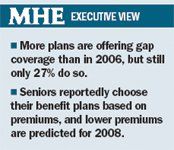Seniors in Part D donut hole unlikely to have gap coverage
Although as many as 48% of seniors were subject to some type of drug-coverage deficiency in 2006, only an estimated 4 million of the 22.5 million enrolled in Medicare drug plans were actually expected to hit the infamous donut hole. There could still be financial woes, however, for the 10.8 million Medicare beneficiaries who at least have the potential for out-of-pocket costs in the donut hole gap because they do not qualify for a subsidy, are not covered outside Part D, or did not pay for enhanced gap coverage.
ALTHOUGH AS MANY as 48% of seniors were subject to some type of drug-coverage deficiency in 2006, only an estimated 4 million of the 22.5 million enrolled in Medicare drug plans were actually expected to hit the infamous donut hole. There could still be financial woes, however, for the 10.8 million Medicare beneficiaries who at least have the potential for out-of-pocket costs in the donut hole gap because they do not qualify for a subsidy, are not covered outside Part D, or did not pay for enhanced gap coverage.
A PricewaterhouseCoopers study estimates that 38% of seniors have coverage outside of Part D; 23% are under low income subsidy, and therefore the gap is covered; 6% have enhanced plans with some gap coverage; and 16% do not spend enough to reach the donut hole.

"Beneficiaries have to make decisions about which drugs to take, or cut back on doses, which can present a higher risk of morbidity and mortality," says Babette Edgar, senior vice president, strategic business solutions for Gorman Health Group in Washington, D.C., which provides counsel and services to Medicare and Medicaid private sector partners. Besides less-expensive therapeutic alternatives, she recommends pill splitting when appropriate.
According to an estimate made in September by America's Health Insurance Plans (AHIP) member organizations, 3 million beneficiaries were predicted to reach the gap in 2006 with about 10% of Medicare beneficiaries having already hit the gap as of last September.
AHIP recommends cost-cutting strategies to help beneficiaries lower their out-of-pocket costs:
AHIP also promotes the use of generic substitution when appropriate, which could save beneficiaries between $350 and $800 per drug per year and prevent or delay them from falling into the coverage gap, according to a Consumers Union survey. The use of formulary management techniques could potentially save individuals 20% to 25% off retail prices for prescription drugs, according to the Congressional Budget Office.
SETTING THE PACE
Not surprisingly, the Pharmaceutical Care Management Assn. (PCMA), a national association representing pharmacy benefit managers (PBMs), touts the use of mail service and generics to help beneficiaries avoid or delay entry into the donut hole; however, PCMA President Mark Merritt says that many beneficiaries are not taking advantage of those tools because they are not aware of them.
David Calabrese of OptumRx Talks New Role, Market Insulin Prices and Other Topics 'On His Mind'
April 13th 2023In this month’s episode of the "What's On Your Mind podcast," Peter Wehrwein, managing editor of MHE connects with the now Chief Clinical Officer of OptumRx Integrated Pharmacies, David Calabrese. In this conversation, David touches on his transition in January as OptumRx’s former chief pharmacy officer and market president of health plans and PBMs to his new role as Chief Clinical Officer where he now focuses more on things such as specialty pharmacy to home delivery — with an overall goal of creating whole-patient care. Throughout the conversation, Calabrese also touched on the market’s hot topic of insulin prices and behavioral health services within the OptumRx community, among other topics.
Listen
Briana Contreras, editor of Managed Healthcare Executive, spoke with Nancy Lurker, CEO and president of EyePoint Pharmaceuticals. Nancy shared a bit about EyePoint and how the organization’s innovative therapies are addressing patient needs through eye care, and most importantly, she addressed C-Suite positions like the CEO role. Nancy shared advice for those seeking to reach the CEO level, especially toward women in healthcare and other roles, and what it takes to run a biopharma company.
Listen